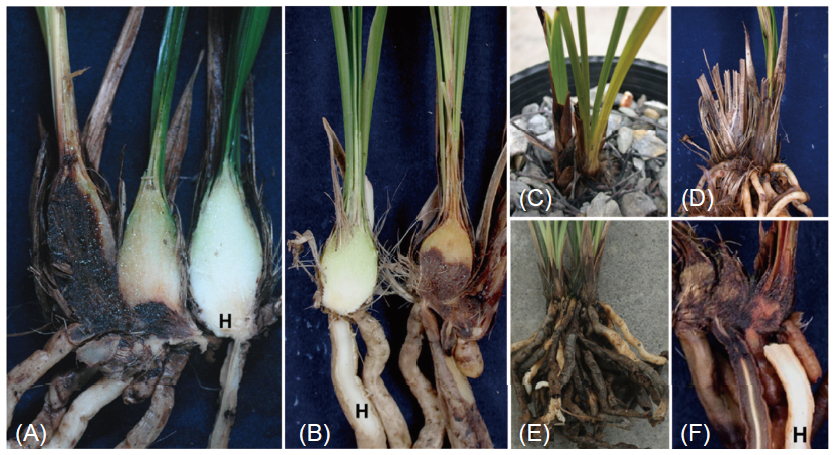All issues

Author:Chiao-Wen Huang, Jin-Hsing Huang*, Yi-Ching Li, Chun-Wei Chen, and Ting-Fang Hsieh
Abstract:
A kind of disease causing pseudobulb rot disease was commonly observed in Cymbidium cultivation area in Taiwan. The disease symptoms included yellowing or withering of leaves and finally plant death. All the infected plants showed brown rot of pseudobulb and root. Two strains of Fusarium sp. showing different colony types were consistently isolated from the infected pseudobulbs and roots. On potato dextrose agar at 25–30℃ cultured under 12 h photoperiod for more than 2 weeks, type-I isolates presented light purple colony and type-II isolates presented terra yellow colony. In disease investigation, the isolation frequency of type-I Fusarium was much higher than type-II Fusarium. Both of these two types of Fusarium sp. were identified as Fusarium oxysporum based on morphological characteristics as well as sequence analysis of the internal transcribed spacer (ITS) and translation elongation factor 1 alpha (TEF-1α) genes. Pathogenicity test of these two pathogens on Cymbidium sinense and Cymbidium ensifolium (by inoculation of spore suspension on root, pseudobulb and leaf) was confirmed for fulfilling the Koch’s postulates. The temperature range for mycelial growth of these two types of pathogen was the same at 16–32℃ (optimal at 24–28℃), and for spore germination was the same at 16–36℃ (optimal at 24–36℃). The temperature range for disease development of type-1 F. oxysporum was 15–30℃ (optimal at 25–30℃). The host range test showed that these two types of pathogen could infect C. sinense, C. ensifolium and Cymbidium hookerianum, but not other tested orchids, such as Oncidium flexuosum, Paphiopedilum insigne, Cattleya and Dendrobium moniliforme.
Key words:Cymbidium, Pseudobulb, Root rot, Fusarium oxysporum
Download:![]() PDF Links
PDF Links
- 1. Using Digital Soil Mapping to Predict Soil Organic Carbon Stocks in Zhuoshui River Basin
- 2. Development of a Technique for Forecasting (or Pre-Detection) Anthracnose Disease Incidences of Green Mature Bagging Mango Fruits
- 3. Taxonomic Review of the Genus Asiophrida Medvedev, 1999 in Taiwan (Insecta: Coleoptera: Chrysomelidae: Galerucinae: Alticini), with Notes on Biology
 Submit your manuscript
Submit your manuscript
 Guide for authors
Guide for authors